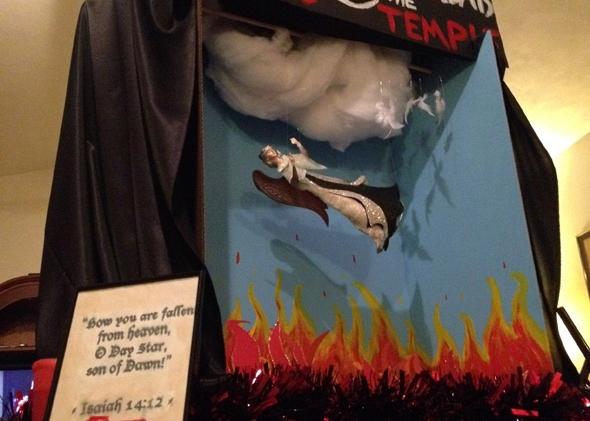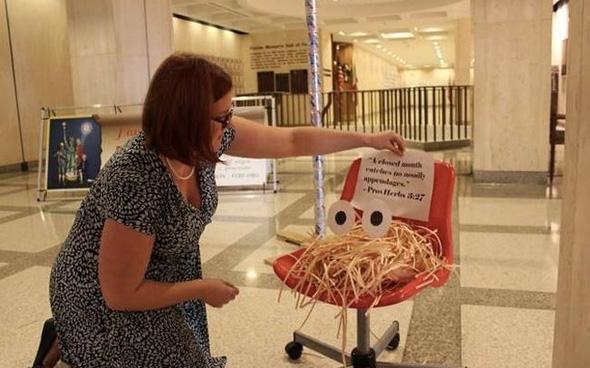Every December, I return to my hometown of Tallahassee, Florida, for several days to spend time with my family. There has not been much to do in Tallahassee ever since our sole arthouse theater was replaced by a Whole Foods. For several years, however, my mom and I have maintained a delightful pre-Christmas tradition: We trek down to the phallic state capitol, enter the rotunda, and enjoy the holiday displays—which have, in the past, included a Satanic Temple diorama, a tribute to the Flying Spaghetti Monster, and a Festivus pole made out of beer cans (2014) or wrapped in rainbow flags and adorned with a disco ball (2015).
Our trip to the rotunda is much more than a quintessentially Floridian photo-op. It is a visit to a constitutional battleground, a physical space that represents the clash of legal precepts built into our founding charter. The capitol rotunda is the malformed offspring of a series of terrible conservative Supreme Court rulings designed to let the government promote religion more robustly. It is a warning, a cautionary tale, a representation of what happens when the state entangles itself with religion. Could a church-state separatist Jew like me dream up a better holiday tradition?

Doug Mesner
A bit of background: In the 1980s, the Supreme Court ruled that religious displays, like a nativity scene or menorah, could be erected in government buildings. Left-leaning justices argued, correctly, that the First Amendment’s Establishment Clause—which forbids the government from promoting religion—should bar such displays, since they appear to endorse specific religious beliefs. But a conservative majority disagreed, insisting that the “celebration of a public holiday with traditional symbols” served a “legitimate secular purposes” and thus comported with the Establishment Clause.
These rulings opened the door to religious groups that were eager to place mementos of their faith on government property. Initially, city officials probably assumed that they could reject those religious displays which they deemed inappropriate. But in 1995, a conservative Supreme Court majority yanked that right away from them in, ironically, another ruling designed to let the state aid religion. The court ruled that when the government opens up a forum for speech, it doesn’t get to choose who can express themselves or how they do it—even when the forum is state-funded, and the expression is explicitly religious. Put simply, when the government creates a public forum for the exchange of ideas, and can’t pick and choose which ideas are permissible. All expression must be allowed.
It doesn’t take a legal scholar to put these decisions together and figure out the odd loophole they create. When the government invites religious groups to place expressions of their faith on government property, it turns that property into a public forum. Once the government has created a public forum, it loses the ability to decide which expression is permitted and which is forbidden. A state eager to promote religion in its buildings has two options: Accept all displays, or refuse to accept any.

Venganza.org
Florida learned this lesson the hard way in 2014 when the Satanic Temple asked to erect a diorama featuring an angel falling into a pit of hellfire in the state capitol. Government officials rejected the display, but the Satanic Temple threatened to sue, alleging a violation of its free speech rights, since the state permitted Christian and Jewish displays. Florida eventually caved under legal pressure. The diorama joined a Flying Spaghetti Monster tribute and a Festivus pole made of beer cans. You better believe I visited it.
The satanic display made no appearance in 2015; the Satanists had made their point. In its place was a rainbow gay pride Festivus pole constructed by professional provocateur Chaz Stevens. As Stevens explained to me at the time, he chose the gay pride theme because of Kim Davis’ anti-gay crusade in Kentucky. “That just drove me nuts,” Stevens told me. “The very day that happened, I said to myself, those little fuckers! I am going to troll the living shit out of them. I’m going to wrap my pole in gay pride and put a disco ball on the top and stick it in the bowels of the Florida rotunda.” If that’s not free speech in action, what is?
This year, Stevens has built a new all-black, 6-foot-tall Festivus pole paying tribute to black victims of police brutality that will contain the names of every unarmed black man killed by police in 2016. My mom and I are devilishly excited to visit it. Unorthodox holiday displays have also cropped up in other capitols; if you’re near one around Christmastime, check it out—you might be in for a delightful surprise. Because I don’t believe in Jesus, I’ve always seen Christmas as an excellent opportunity to reflect on the bountiful gifts of liberty that our founding fathers bestowed upon us. There is no better way to do that than to gaze at the majesty of a shoddily constructed satanic diorama and reflect on the glory of our precious First Amendment.
